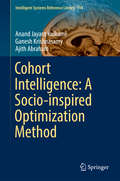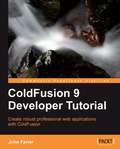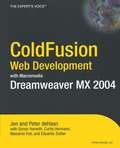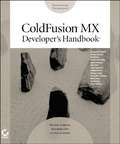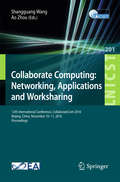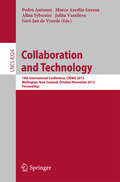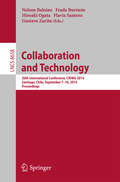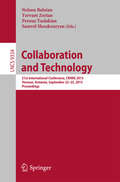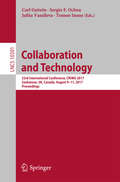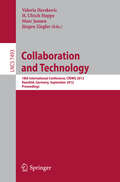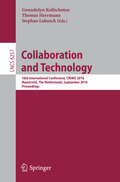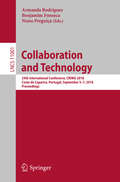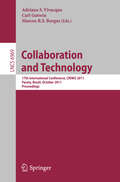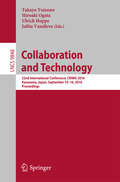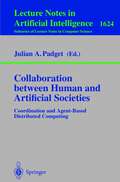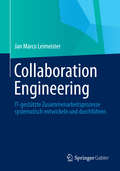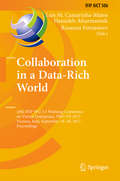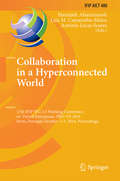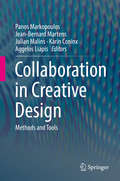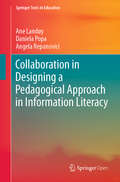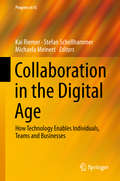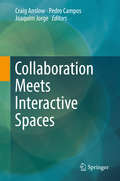- Table View
- List View
Cohort Intelligence: A Socio-inspired Optimization Method (Intelligent Systems Reference Library #114)
by Anand Jayant Kulkarni Ganesh Krishnasamy Ajith AbrahamThis Volume discusses the underlying principles and analysis of the different concepts associated with an emerging socio-inspired optimization tool referred to as Cohort Intelligence (CI). CI algorithms have been coded in Matlab and are freely available from the link provided inside the book. The book demonstrates the ability of CI methodology for solving combinatorial problems such as Traveling Salesman Problem and Knapsack Problem in addition to real world applications from the healthcare, inventory, supply chain optimization and Cross-Border transportation. The inherent ability of handling constraints based on probability distribution is also revealed and proved using these problems.
Cold Cases: Evaluation Models with Follow-up Strategies for Investigators, Second Edition
by James M. Adcock Sarah L. SteinBecause the investigation of cold cases is usually an arduous and time-consuming task, most law enforcement agencies in the United States are not able to dedicate the resources necessary to support the cold case investigation process. However, when those cases are fully pursued and prosecuted, they often result in convictions and lengthy prison ter
The Cold Start Problem: Using Network Effects to Scale Your Product
by Andrew ChenA transformative guide to growing any business, from one of Silicon Valley's most esteemed investorsFinancial Times Business Book of the Month'A true Silicon Valley insider' WiredWhy do some products take off? And what can we learn from them?The hardest part of launching a product is getting started. When you have just an idea and a handful of customers, growth can feel impossible. This is the cold start problem.Andrew Chen has a solution. As a partner at the pre-eminent VC firm Andreesen Horowitz, he has invested in some of the world's fastest-growing companies. Along the way, he's become one of the most renowned bloggers in tech - hailed by Wired as a 'true Silicon Valley insider'.Now, Chen reveals how any organisation can surmount the cold start problem. His solution lies in the network effect: the way a service improves as more people sign up. It means that today's leading products - from Wikipedia to to WhatsApp - get more powerful with every additional user.Drawing on interviews with the founders of LinkedIn, Zoom, Uber, Dropbox, Tinder, Airbnb and more, Chen unpicks how to start and scale these network effects. He reveals how to build an 'atomic network' that is just big enough to sustain itself. He uncovers how to spot the tipping point after which growth takes care of itself. And he explores why some big companies manage to sustain viral network effects for years (while others quickly stop growing). The result is a one-stop guide to scaling a product, road-tested at some of the world's most valuable companies. Praise for Andrew Chen'Andrew's blog is an inexhaustible source of numbers and ideas on concepts that matter' Max Levchin, co-founder of PayPal'Here's one message you want. Chen's weekly newsletter offers thoughtful essays on startups and marketing' Wired'One of the best entrepreneurship blogs of all time' Eric Ries, author of The Lean Startup
ColdFusion 9 Developer Tutorial
by John FarrarThis book is a fast-paced tutorial to developing ColdFusion applications, with an emphasis on real-world skills. Packed with examples and careful explanations, the book leads you through all the topics relevant to today's ColdFusion developer. This book is for web developers working with ColdFusion 9. If your goal is to get a good grounding in the basics of the language as quickly as possible and put a site together quickly, this book is ideal for you. This book will also help you if you want to learn more about professional programming of ColdFusion. No prior knowledge of ColdFusion is expected, but basic knowledge of general web and software development skills is assumed.
ColdFusion Web Development with Macromedia Dreamweaver MX 2004
by Peter de Haan Curtis Hermann Simon Horwith Edoardo Zubler Massimo Foti* Competitively priced, comprehensively illustrated, with in-depth "real world" applied content. There are only 2 other books that approach this subject matter, and our book is more concise, practical, and reaches a more advanced level that than the others. All source code for examples and case study will be openly available for download from www.apress.com. * In-depth final case study – in the final chapter we explore the planning, design, and implementation of an entire fully working website, using all of the code, concepts, and techniques learnt in earlier chapters. This highly applied look at integrating ColdFusion and Dreamweaver in a complete project unifies all of the concepts learnt and takes our book above and beyond the competitors, which rely heavily on theory and small isolated examples. * The authors (in Particular Jen deHaan, Massimo Foti and Simon Horwith) are highly experienced and renowned members of the Dreamweaver and ColdFusion web communities.
ColdFusion MX Developer's Handbook
by Raymond Camden Arman Danesh Hal Helms Guy Rish Emily Kim Shlomy Gantz Jen deHaan Peter deHaan Charles Mohnike Selene Bainum John Colasante William Baum Kenneth N. Fricklas Matt LiottaColdFusion is an extremely powerful web-development tool. Despite its short initial learning curve, attributed to its accessible HTML-like, tag-based syntax, it provides sophisticated content-management solutions for large-scale enterprises. This has never been truer than it is now, since the release of ColdFusion MX. To take advantage of this power, you must step outside the box to learn skills as diverse as application design and Web Services development--topics addressed only briefly, if at all, in standard ColdFusion tutorials and reference books. ColdFusion MX Developer's Handbook teaches you what you need to broaden your ColdFusion skills and become a fully capable enterprise developer. Inside, 13 ColdFusion experts provide highly detailed, advanced instruction that will save you countless headaches and let you squeeze every last drop of functionality from the newest release. You'll master database integration techniques involving advanced SQL queries, stored procedures, and database upsizing. You'll take advantage of MX's improved integration with other technologies, incorporating Flash using Flash Remoting, and capitalizing on full XML support to create Web Services. In your custom coding, you'll build and deploy Java and C++ extensions and wirelessly extend ColdFusion's reach with components that talk to WAP and WML clients. All this comes wrapped in practical, hard-to-find advice for managing your content and applications and optimizing performance. Large applications with heavy traffic need speed and efficiency, and you get that with performance turning, load balancing, and caching. If you're working in a clustered environment, you need to understand state management. No matter what your situation, you'll benefit from in-depth coverage of application security, debugging, and coding methodology using Fusebox. Every chapter is packed with the technical knowledge to give you what you need to create serious solutions. You might find that one particular chapter alone is worth the cost of the book because of the time and frustration it will save you. Most readers, however, will use various parts of this book at different times, depending on the constantly changing challenges faced by enterprise programmers. The mission of this book is to provide the extra skills you need to be a successful ColdFusion developer in today's demanding and expanding environment.
Collaborate Computing: 12th International Conference, CollaborateCom 2016, Beijing, China, November 10–11, 2016, Proceedings (Lecture Notes of the Institute for Computer Sciences, Social Informatics and Telecommunications Engineering #201)
by Shangguang Wang Ao ZhouThis book constitutes the thoroughly refereed proceedings of the 12th International Conference on Collaborative Computing: Networking, Applications, and Worksharing, CollaborateCom 2016, held in Beijing, China, in November 2016. The 66 papers presented were carefully reviewed and selected from 116 submissions and focus on topics such as: participatory sensing, crowdsourcing, and citizen science; architectures, protocols, and enabling technologies for collaborative computing networks and systems; autonomic computing and quality of services in collaborative networks, systems, and applications; collaboration in pervasive and cloud computing environments; collaboration in data-intensive scientific discovery; collaboration in social media; big data and spatio-temporal data in collaborative environments/systems; collaboration techniques in data-intensive computing and cloud computing.
Collaboration and Technology: 19th International Conference, CRIWG 2013, Wellington, New Zealand, October 30 - November 1, 2013, Proceedings (Lecture Notes in Computer Science #8224)
by Pedro Antunes Marco Aurélio Gerosa Allan Sylvester Julita Vassileva Gert-Jan De VreedeThis book constitutes the proceedings of the 19th Collaboration Researchers' International Working Group Conference on Collaboration and Technology, held in Wellington, New Zealand, in October/November 2013. The 18 revised papers presented together with 4 progress papers were carefully reviewed and selected from 34 submissions. They are organized into six thematic sessions as follows social media, social networks, crowdsourcing, learning, collaboration design and software development.
Collaboration and Technology: 20th International Conference, CRIWG 2014, Santiago, Chile, September 7-10, 2014, Proceedings (Lecture Notes in Computer Science #8658)
by Nelson Baloian Frada Burstein Hiroaki Ogata Flavia Santoro Gustavo ZuritaThis book constitutes the proceedings of the 20th Collaboration Researchers' International Working Group Conference on Collaboration and Technology, held in Santiago, Chile, in September 2014.The 16 revised papers presented together with 18 progress papers and 3 invited talks were carefully reviewed and selected from 49 submissions. The papers published in proceedings of this year's and past CRIWG conferences reflect the trends in collaborative computing research and its evolution. There was a growing interest in social networks analysis, crowdsourcing and computer support for large communities in general. A special research topic which has been traditionally present in the CRIWG proceedings has been collaborative learning.
Collaboration and Technology: 21st International Conference, CRIWG 2015, Yerevan, Armenia, September 22-25, 2015, Proceedings (Lecture Notes in Computer Science #9334)
by Nelson Baloian Yervant Zorian Perouz Taslakian Samvel ShoukouryanThis book constitutes the refereed proceedings of the 21st International Conference on Collaboration and Technology, CRIWG 2015, held in Yerevan, Armenia, in September 2015.The 19 revised papers presented together with 1 invited talk were carefully reviewed and selected from 28 submissions. CRIWG has been focused on collaboration technology design, development, and evaluation. The background research is influenced by a number of disciplines, such as computer science, management science, informationsystems, engineering, psychology, cognitive sciences, and social sciences.
Collaboration and Technology: 23rd International Conference, CRIWG 2017, Saskatoon, SK, Canada, August 9-11, 2017, Proceedings (Lecture Notes in Computer Science #10391)
by Carl Gutwin Sergio F. Ochoa Julita Vassileva Tomoo InoueThis book constitutes the refereed proceeding of the 23rd International Conference on Collaboration and Technology, CRIWG 2017, held in Saskatoon, Canada, in August 2017. The 14 full papers presented together with 5 work-in-progress papers were carefully reviewed and selected from 33 submissions. The papers focus on collaboration technology design, development, and evaluation. The background research is influenced by a number disciplines, such as computer science, management science, information systems, engineering, psychology, cognitive sciences, and social sciences
Collaboration and Technology: 18th International Conference, CRIWG 2012, Raesfeld, Germany, September 16-19, 2012, Proceedings (Lecture Notes in Computer Science #7493)
by Valeria Herskovic H. Ulrich Hoppe Jürgen Ziegler Marc JansenThis book constitutes the proceedings of the 18th Collaboration Researchers' International Working Group Conference on Collaboration and Technology, held in Raesfeld, Germany, in September 2012. The 9 revised papers presented together with 12 short papers were carefully reviewed and selected from numerous submissions. They are grouped into five themes that represent collaborative learning, social media analytics, conceptual and design models, formal modeling and technical approaches and collaboration support in emergency scenarios.
Collaboration and Technology: 16th International Conference, CRIWG 2010, Maastricht, The Netherlands, September 20-23, 2010, Proceedings (Lecture Notes in Computer Science #6257)
by Gwendolyn Kolfschoten Thomas Herrmann Stephan LukoschThis book constitutes the proceedings of the 16th Collaboration Researchers' International Working Group Conference on Collaboration and Technology, held in Maastricht, The Netherlands, in September 2010.The 27 revised papers presented were carefully reviewed and selected from numerous submissions. They are grouped into seven themes that represent current areas of interest in groupware research: knowledge elicitation, construction and structuring, collaboration and decision making, collaborative development, awareness, support for groupware design, social networking and mobile collaboration.
Collaboration and Technology: 24th International Conference, CRIWG 2018, Costa de Caparica, Portugal, September 5-7, 2018, Proceedings (Lecture Notes in Computer Science #11001)
by Armanda Rodrigues Benjamim Fonseca Nuno PreguiçaThis book constitutes the refereed proceedings of the 24th International Conference on Collaboration and Technology, CRIWG 2018, held in Costa de Caparica, Portugal, in September 2018.The 11 revised full papers presented together with 6 short papers were carefully reviewed and selected from 32 submissions. The papers published in the proceedings of this year span dierent areas of collaborative computing research, from collaborative learning to collaboration through social media and virtual communities.
Collaboration and Technology: 17th International Conference, CRIWG 2011, Paraty, Brazil, October 2-7, 2011, Proceedings (Lecture Notes in Computer Science #6969)
by Adriana S. Vivacqua Carl Gutwin Marcos R. S. BorgesThis book constitutes the proceedings of the 17th Collaboration Researchers' International Working Group Conference on Collaboration and Technology, held in Paraty, Brazil, in October 2011. The 12 revised papers presented together with 6 short papers were carefully reviewed and selected from numerous submissions. They are grouped into four themes that represent current areas of interest in groupware research: theoretical foundation, empirical studies, methods and techniques, and tools for communication and cooperation.
Collaboration and Technology: 22nd International Conference, CRIWG 2016, Kanazawa, Japan, September 14-16, 2016, Proceedings (Lecture Notes in Computer Science #9848)
by Takaya Yuizono Hiroaki Ogata Ulrich Hoppe Julita VassilevaThis book constitutes the refereed proceedings of the 22nd International Conference on Collaboration and Technology, CRIWG 2016, held in Kanazawa, Japan, in September 2016.The 10 revised full papers presented together with 3 work-in-progress papers werecarefully reviewed and selected from 27 submissions. The papers reflect the current diversity of collaborative computing research and its evolution and deal with topics such as group support, AR and 3D technology, wearable technology, intercultural collaboration, remote physical tasks, recommendation systems, collaborative learning, and health support.
Collaboration between Human and Artificial Societies: Coordination and Agent-Based Distributed Computing (Lecture Notes in Computer Science #1624)
by Julian A. PadgetThe full title of the HCM network project behind this volume is VIM: A virtual multicomputer for symbolic applications. The three strands which bound the network together were parallel systems, advanced compilation techniques andarti?cialintelligence witha commonsubstrate in the programminglanguage Lisp. The initial aim of the project was to demonstrate how the combination of these three technologies could be used to build a virtual multicomputer — an ephemeral, persistent machine of available heterogeneous computing resources — for large scale symbolic applications . The system would support a virtual processor abstraction to distribute data and tasks across the multicomputer, the actual physical composition of which may change dynamically. Our practical objective was to assist in the prototyping of dynamic distributed symbolic app- cations in arti?cial intelligence using whatever resources are available (probably networked workstations), so that the developed program could also be run on more exotic hardware without reprogramming. What we had not foreseen at the outset of the project was how agents would unify the strands at the application level, as distinct from the system level o- lined above. It was as a result of the agent in?uence that we held two workshops in May and December 1997 with the title “Collaboration between human and arti?cial societies”. The papers collected in this volume are a selection from presentations made at those two workshops. In each case the format consisted of a number of invited speakers plus presentations from the network partners.
Collaboration Engineering: IT-gestützte Zusammenarbeitsprozesse systematisch entwickeln und durchführen
by Jan Marco LeimeisterIn Zeiten verteilter Wertschöpfungsstrukturen spielt die effektive Zusammenarbeit eine entscheidende Rolle im Kampf um Wettbewerbsvorteile. Diese Zusammenarbeit in Form von übertragbaren Prozessen zu gestalten, ist Kern des Collaboration Engineerings. Das Buch liefert einen umfassenden, auch für den Laien verständlichen Einblick in die Konzepte und Methoden, Werkzeuge und Anwendungen computerunterstützter Zusammenarbeit und betrachtet ihre Potenziale und Perspektiven. Ein Lehrbuch für Studierende und zugleich Handbuch für Entwickler und Anwender.
Collaboration in a Data-Rich World: 18th IFIP WG 5.5 Working Conference on Virtual Enterprises, PRO-VE 2017, Vicenza, Italy, September 18-20, 2017, Proceedings (IFIP Advances in Information and Communication Technology #506)
by Luis M. Camarinha-Matos, Hamideh Afsarmanesh and Rosanna FornasieroThis book constitutes the refereed proceedings of the 18th IFIP WG 5.5 Working Conference on Virtual Enterprises, PRO-VE 2017, held in Vicenza, Italy, in September 2017. The 68 revised full papers were carefully reviewed and selected from 159 submissions. They provide a comprehensive overview of identified challenges and recent advances in various collaborative network (CN) domains and their applications, with a strong focus on the following areas: collaborative models, platforms and systems for data-rich worlds; manufacturing ecosystem and collaboration in Industry 4.0; big data analytics and intelligence; risk, performance, and uncertainty in collaborative data-rich systems; semantic data/service discovery, retrieval, and composition in a collaborative data-rich world; trust and sustainability analysis in collaborative networks; value creation and social impact of collaboration in data-rich worlds; technology development platforms supporting collaborative systems; collective intelligence and collaboration in advanced/emerging applications: collaborative manufacturing and factories of the future, e-health and care, food and agribusiness, and crisis/disaster management.
Collaboration in a Hyperconnected World: 17th IFIP WG 5.5 Working Conference on Virtual Enterprises, PRO-VE 2016, Porto, Portugal, October 3-5, 2016, Proceedings (IFIP Advances in Information and Communication Technology #480)
by Hamideh Afsarmanesh Luis M. Camarinha-Matos António Lucas SoaresThis book constitutes the refereed proceedings of the 17th IFIP WG 5.5 Working Conference on Virtual Enterprises, PRO-VE 2016, held in Porto, Portugal, in October 2016. The 57 revised papers were carefully reviewed and selected from 148 submissions. They provide a comprehensive overview of identified challenges and recent advances in various collaborative network (CN) domains and their applications, with a strong focus on the following areas: hyperconnected systems, managing data and knowledge, networked business processes, collective intelligence and decision making, creating supply and production networks, operating and management of networks, collaborative engineering, product services, intelligent product ecosystems, product personalization, service orientation, cloud technology aspects for VOs, design science research, business models in hyperconnected context, agribusiness value chain, and collaborative networks in circular economy.
Collaboration in Creative Design: Methods and Tools
by Panos Markopoulos Jean-Bernard Martens Julian Malins Karin Coninx Aggelos LiapisThis book presents a number of new methods, tools, and approaches aimed to assist researchers and designers during the early stages of the design process, focusing on the need to approach the development of new interactive products, systems and related services by closely observing the needs of potential end-users through adopting a design thinking approach. A wide range of design approaches are explored, some emphasizing on the physicality of interaction and the products designed, others exploring interactive design and the emerging user experience (UX) with a focus on the value to the end-user. Contemporary design processes and the role of software tools to support design are also discussed. The researchers draw their expertise from a wide range of fields and it is this interdisciplinary approach which provides a unique perspective resulting in a flexible collection of methods that can be applied to a wide range of design contexts. Interaction and UX designers and product design specialists will all find Collaboration in Creative Design an essential read.
Collaboration in Designing a Pedagogical Approach in Information Literacy (Springer Texts in Education)
by Ane Landøy Daniela Popa Angela RepanoviciThis Open Access book combines expertise in information literacy with expertise in education and teaching to share tips and tricks for the development of good information literacy teaching and training in universities and libraries. It draws on research, knowledge and pedagogical practice from academia, to teach students how to sift through information to be able to distinguish the important and correct from the unusable. It discusses basic concepts and models of information literacy, as well as strategies for accessing, locating and retrieving information and methods suitable for the assessment and management of information. The book explains many concepts connected to information literacy and discusses pedagogical issues with a view to supporting the practitioner. Each chapter examines one aspect of information literacy, discusses the pedagogical challenges involved and provides suggestions for best practice.
Collaboration in the Digital Age: How Technology Enables Individuals, Teams and Businesses (Progress in IS)
by Kai Riemer Stefan Schellhammer Michaela MeinertThis book examines how digital technologies enable collaboration as a way for individuals, teams and businesses to connect, create value, and harness new opportunities. Digital technologies have brought the world closer together but also created new barriers and divides. While it is now possible to connect almost instantly and seamlessly across the globe, collaboration comes at a cost; it requires new skills and hidden ‘collaboration work’, and the need to renegotiate the fair distribution of value in multi-stakeholder network arrangements. Presenting state-of-the-art research, case studies, and leading voices in the field, the book provides academics and professionals with insights into the diverse powers of collaboration in the digital age, spanning collaboration among professionals, organisations, and consumers. It brings together contributions from scholars interested in the collaboration of teams, cooperatives, projects, and new cooperative systems, covering a range of sectors from the sharing economy, health care, large project businesses to public sector collaboration.
Collaboration Meets Interactive Spaces: Theory And Practice
by Craig Anslow Pedro Campos Joaquim JorgeThis book explores the technological advances and social interactions between interactive spaces, surfaces and devices, aiming to provide new insights into emerging social protocols that arise from the experimentation and long-term usage of interactive surfaces. This edited volume brings together researchers from around the world who investigate interactive surfaces and interaction techniques within large displays, wearable devices, software development, security and emergency management. Providing both theory and practical case studies, the authors look at current developments and challenges into 3D visualization, large surfaces, the interplay of mobile phone devices and large displays, wearable systems and head mounted displays (HMD’S), remote proxemics and interactive wall displays and how these can be employed throughout the home and work spaces. Collaboration Meets Interactive Spaces is both for researchers and industry practitioners, providing readers with a coherent narrative into the current state-of-the-art within interactive surfaces and pervasive display technology, providing necessary tools and techniques as interactive media increasingly permeates everyday contexts.
Collaboration Potential in Virtual Reality: Transforming the Workplace of Tomorrow (SpringerBriefs in Business)
by Marko OrelThe recent shift in labour markets has heightened the demand for alternative work arrangements. Virtual reality (VR) technology plays a significant role in this transition, with remote work as efficient as work performed from an organization's own office space. This book explores the impact of immersive VR technology on the new virtual workspace. Specifically, it examines how VR can enable employees to overcome the distractions associated with working from home, increase their visibility on team projects, build stronger relationships with co-workers, reduce feelings of isolation due to social distancing, and facilitate their engagement in collaborative work processes. It also explores the limitations of two-dimensional, computer-mediated communication tools for flexible working arrangements. It, thus, offers theoretical foundations for future research on office digitalization and subsequent applications of VR technology on office work. It also features the analysis of two dozen problem-centered expert interviews with creators and executives of leading productivity VR tools that enable the remote collaboration between knowledge workers.
